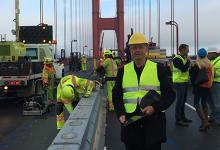
The level of future uncertainty in transportation planning - specifically in addressing congestion on urban freeways - has increased significantly over the past few years. The impact of connected and autonomous vehicles on traffic flow, of Mobility as a Service (MaaS) initiatives, particularly the car-sharing elements, and exciting advances in traffic operations are some of the factors contributing to this uncertainty.
The US
The study by Danial Rathbone** examines these two options, timelines and costs for reducing congestion. One option is widening a congested urban freeway by constructing one additional lane in each direction. The other option is providing a reversible lane using moveable barrier to create an additional lane during the traditional morning and late afternoon peak periods of travel.
Main findings of the report focussed on comparing costs, time from design to operation and environmental issues.
The cost for constructing a lane-mile to widen an urban freeway averages US$28 million. In contrast, the cost of a reversible contraflow lane is $1.4 million per mile.
The typical length of time to plan, design and construct an additional lane is 10 years. Equivalent time for a reversible lane is one to four years.
Environmental issues associated with construction of an additional lane requires an impact study and statement which typically takes three years to complete. Meanwhile, a reversible lane is usually exempt from such a study as the main infrastructure is already in place.
Construction of an additional freeway lane is typically a one-off. However, it is a very large investment for something which may not be needed if the trends upon which the project were based fail to materialise. Reversible lanes, however, using movable barriers, are flexible in terms of coping with existing and future traffic volumes by changing the number of contraflow lanes – a low-risk investment. By their nature they adapt to changing traffic volumes.
California
In September 2016, the US state of California passed a law requiring that, prior to the California Transportation Commission approving a capacity-increasing project or major street or highway lane realignment project, the California Department of Transportation (
In fact, reversible lanes are not new to California. They have been used on the 2.7km Golden Gate Bridge since 1963 where they reduced severe traffic in the peak direction. However, they were labour-intensive to operate and posed serious safety problems because they led to the increase in head-on collisions.
Reversible lanes are also in use on the 3.4km San Diego-Coronado Bridge, along the Interstate 15 freeway in San Diego and, until recently, in the 1.1km Caldecott Tunnel in Oakland, California. More recently, Lindsay’s Road Zipper has been adopted in the San Francisco area of California and much further north, in the Pacific coast city of Vancouver, Canada.
In March, Lindsay signed a deal with the Bay Area Transportation Authority to deploy its Road Zipper System on the 8.8km Richmond-San Rafael Bridge in San Francisco. The moveable barrier technology will be used to create a bicycle and pedestrian walkway across the bridge. Lindsay’s revenue from this project is valued at around $9 million.
The project calls for moveable barrier to be installed on the north side of the upper deck of the bridge. This throughway will add another section to the planned 800km network of bicycle and hiking routes on the Bay Trail.
Moveable barriers have been used for bicycle lanes in other cities, but the Richmond-San Rafael Bridge installation is special, explains Chris Sanders, senior vice president of Lindsay Transportation Solutions.
Each reactive tension segment (RTS) of the chain will be an RTS Guard, a high-performance, high-containment barrier designed to separate bicycle and pedestrian paths from traffic on busy roads and bridges where vehicle encroachment into the path would have a high probability of causing injuries or fatalities. The flexible barrier can be static barrier or quickly changed and easily moved with a barrier transfer machine to expand the path or for maintenance and street cleaning.
RTS Guard increases the height of the barrier from 81cm to nearly 107cm. RTS Guard is tested to MASH TL-3 and the 107cm-high profile keeps cyclists from vaulting the barrier in case of impact. The barrier is pending FHWA approval for MASH TL-3.
BC bound
The San Francisco deal follows an agreement in December with the Canadian province of British Columbia’s Ministry of Transportation. The Road Zipper System will be installed on the Alex Fraser Bridge which connects the adjacent cities of Richmond and New Westminster with North Delta in Greater Vancouver.
The Zipper replaces a static concrete barrier in order to accommodate increased traffic flow during peak periods. Lindsay’s revenue from this project is valued at around $14 million, according to the company.
Opened in 1986, the 2.5km Alex Fraser Bridge was designed to allow for the number of lanes to be increased. When it first opened, only four of the six lanes were used for traffic. As traffic increased, pedestrian and cycling lanes were moved to the perimeter of the bridge so that all six lanes could be used for vehicles.
British Columbian officials will re-stripe the lanes, adding a seventh lane along with the new counterflow moveable barrier system to improve capacity and help reduce traffic congestion during peak periods. An average of 119,000 vehicles move across the bridge every day, and when this project is completed, officials say motorists can expect to save six minutes on their morning northbound commute and 12-16 minutes during the afternoon rush hour heading south.









